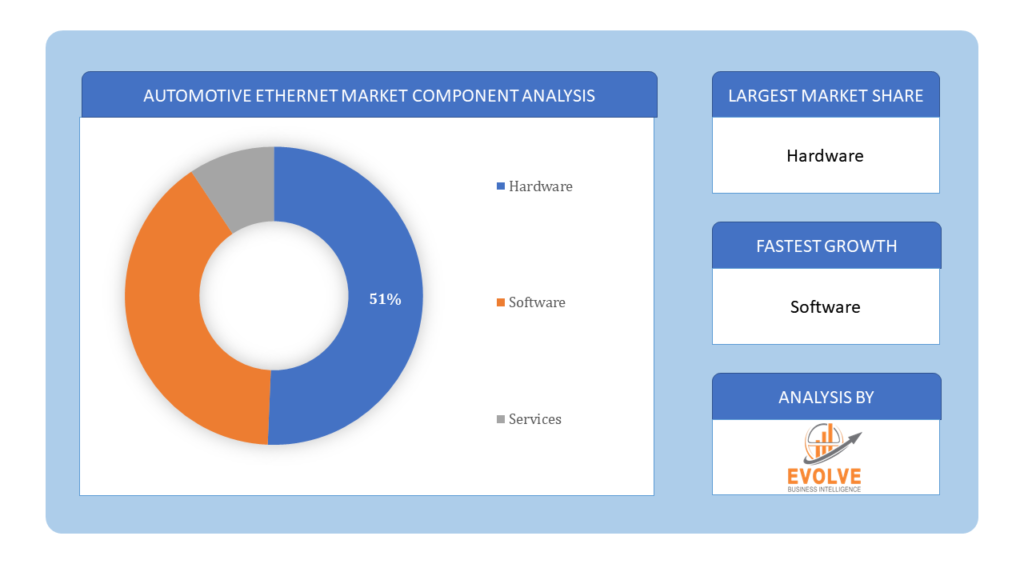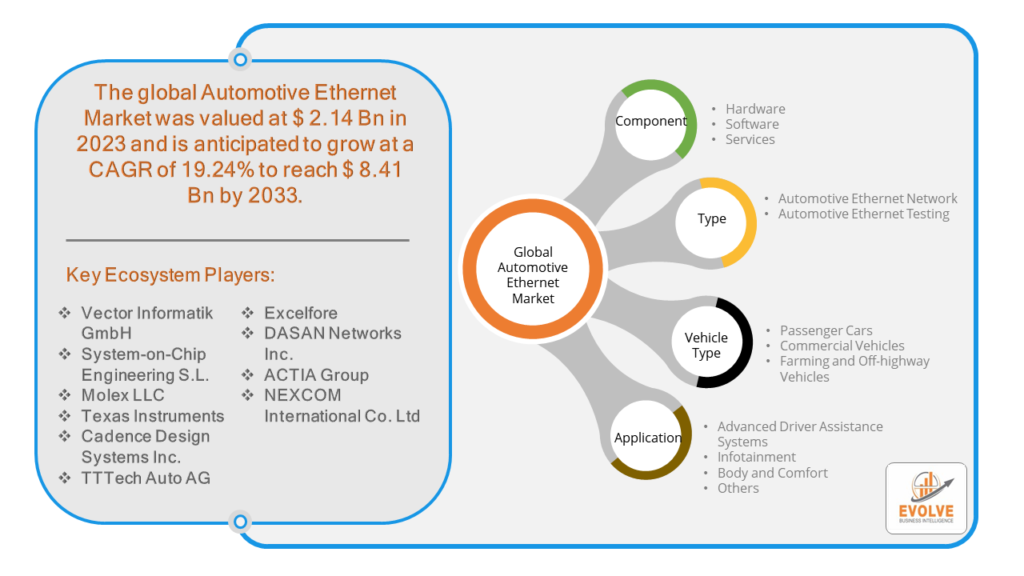Automotive Ethernet Market Analysis and Global Forecast 2023-2033
$ 1,390.00 – $ 5,520.00Price range: $ 1,390.00 through $ 5,520.00
Automotive Ethernet Market Research Report: Information By Component (Hardware, Software, Services), Type (Automotive Ethernet Network, Automotive Ethernet Testing), By Application (Advanced Driver Assistance Systems, Infotainment, Body and Comfort, Others), By Vehicle Type (Passenger Cars, Commercial Vehicles, Farming and Off-highway Vehicles), and by Region — Forecast till 2033
Page: 170
Automotive Ethernet Market Overview
The Automotive Ethernet Market Size is expected to reach USD 8.41 Billion by 2033. The Automotive Ethernet Market industry size accounted for USD 2.14 Billion in 2023 and is expected to expand at a compound annual growth rate (CAGR) of 19.24% from 2023 to 2033. The Automotive Ethernet Market refers to the global market for Ethernet technology used in automotive applications. Ethernet is a widely used networking technology that enables the transmission of data over networks. In the context of the automotive industry, Ethernet is employed to provide high-speed communication among various electronic components and systems within a vehicle.
The Automotive Ethernet Market is expected to grow significantly in the coming years due to the rising adoption of advanced automotive technologies and the increasing complexity of in-vehicle networks and Growing popularity of features that require a lot of data transfer.
Global Automotive Ethernet Market Synopsis
The COVID-19 pandemic had a significant impact on the Automotive Ethernet Market. The pandemic caused significant disruptions in the global supply chain, leading to shortages of key components like semiconductors, which are essential for automotive Ethernet systems. Factory shutdowns and restrictions on the movement of goods and people resulted in delays and reduced production capacities. The pandemic highlighted the importance of in-car connectivity and safety features, driving the adoption of Ethernet for robust and high-speed communication within vehicles. The pandemic has accelerated the shift towards electric and autonomous vehicles, which rely heavily on Ethernet technology for efficient communication between various systems and components.
Automotive Ethernet Market Dynamics
The major factors that have impacted the growth of Automotive Ethernet Market are as follows:
Drivers:
Ø Increasing Complexity of In-Vehicle Networks
The need for high-speed and reliable data communication to support ADAS features like lane departure warning, adaptive cruise control, and automatic emergency braking. Growing consumer demand for sophisticated infotainment systems that offer seamless connectivity, high-definition video streaming, and internet access. Ethernet solutions are often more cost-effective compared to traditional automotive networking technologies, offering a favorable cost-to-performance ratio. Ethernet’s ability to scale from low to high data rates makes it suitable for a wide range of applications within the vehicle, from simple sensor networks to complex infotainment systems. Ethernet supports the reliable and fast communication needed for safety-critical applications, enhancing overall vehicle safety.
Restraint:
- Perception of High Initial Investment Costs
Implementing Ethernet technology in vehicles requires significant investment in new infrastructure, specialized equipment, and training, which can be cost-prohibitive for some manufacturers. Developing and integrating Ethernet solutions necessitates substantial R&D efforts, further increasing initial costs. While Ethernet offers high data rates, achieving the low latency and real-time performance required for certain automotive applications (e.g., safety-critical systems) can be challenging. Automotive environments are subject to extreme temperatures, vibrations, and other harsh conditions. Ensuring that Ethernet components can withstand these conditions and maintain reliable performance is crucial.
Opportunity:
⮚ Rising Demand for Autonomous Vehicles
The increasing adoption of ADAS features requires high-speed, reliable communication networks, making Ethernet an ideal choice. As the industry moves towards higher levels of vehicle autonomy, the need for robust in-vehicle networks to support real-time data processing and sensor fusion will drive demand for Ethernet solutions. Developing advanced cybersecurity measures for Ethernet networks can address growing concerns about vehicle safety and data privacy, making Ethernet more attractive to manufacturers. Ethernet’s capability to support real-time communication is crucial for safety-critical applications, presenting opportunities to enhance overall vehicle safety.
Automotive Ethernet Market Segment Overview
By Component
 Based on Component, the market is segmented based on Hardware, Software and Services. The services segment dominated the market. Services cover a broad spectrum of solutions specifically tailored for complex Ethernet-based systems, including design, testing, integration, maintenance, and support. The need for specialized services is growing as cars become more autonomous, data-centric, and connected. These services are necessary to guarantee reliable integration and strict adherence to automotive standards.
Based on Component, the market is segmented based on Hardware, Software and Services. The services segment dominated the market. Services cover a broad spectrum of solutions specifically tailored for complex Ethernet-based systems, including design, testing, integration, maintenance, and support. The need for specialized services is growing as cars become more autonomous, data-centric, and connected. These services are necessary to guarantee reliable integration and strict adherence to automotive standards.
By Type
Based on Type, the market segment has been divided into the Automotive Ethernet Network and Automotive Ethernet Testing. The Automotive Ethernet Testing segment is dominant the Automotive Ethernet Market. As vehicles integrate more advanced features, the complexity of their ethernet networks grows. This necessitates more rigorous testing. Autonomous vehicles rely heavily on reliable and secure ethernet networks. This will drive the demand for comprehensive testing solutions.
By Vehicle Type
Based on Vehicle Type, the market segment has been divided into the Passenger Cars, Commercial Vehicles and Farming and Off-highway Vehicles. The Passenger Cars segment dominated the market. The automotive ethernet market’s passenger cars subsegment has grown significantly as a result of the strengthening economy, technical developments in passenger cars, such as the addition of a driver assistance system, and rising disposable incomes.
By Application
Based on Application, the market segment has been divided into the Advanced Driver Assistance Systems, Infotainment, Body and Comfort and Others. The Infotainment category generated the most income. The term “infotainment” refers to the combination of entertainment and information systems in cars that improve the ride for passengers. Numerous features are included, including in-car communication systems, multimedia entertainment, navigation, and connection.
Global Automotive Ethernet Market Regional Analysis
Based on region, the global Automotive Ethernet Market has been divided into North America, Europe, Asia-Pacific, the Middle East & Africa, and Latin America. North America is projected to dominate the use of the Automotive Ethernet Market followed by the Asia-Pacific and Europe regions.
 Automotive Ethernet North America Market
Automotive Ethernet North America Market
North America holds a dominant position in the Automotive Ethernet Market. North America, particularly the United States, is a hub for automotive innovation, including the development and adoption of advanced Ethernet technologies. High demand for advanced driver-assistance systems (ADAS) and autonomous vehicles drives the adoption of high-speed networking solutions like Ethernet. The presence of major automotive OEMs and technology providers supports the growth of the Automotive Ethernet Market.
Automotive Ethernet Asia-Pacific Market
The Asia-Pacific region has indeed emerged as the fastest-growing market for the Automotive Ethernet Market industry. Growing urbanization and industrialization in countries like China, Japan, South Korea, and India drive the demand for advanced automotive technologies. Asia-Pacific is one of the largest automotive production regions, with significant investments in advanced vehicle technologies, including Ethernet. Increasing consumer demand for connected and autonomous vehicles supports the growth of the Ethernet market.
Competitive Landscape
The global Automotive Ethernet Market is highly competitive, with numerous players offering a wide range of software solutions. The competitive landscape is characterized by the presence of established companies, as well as emerging startups and niche players. To increase their market position and attract a wide consumer base, the businesses are employing various strategies, such as product launches, and strategic alliances.
Prominent Players:
- Vector Informatik GmbH
- System-on-Chip Engineering S.L.
- Molex LLC
- Texas Instruments
- Cadence Design Systems Inc.
- TTTech Auto AG
- Excelfore
- DASAN Networks Inc.
- ACTIA Group
- NEXCOM International Co. Ltd
Key Development
In July 2023, NXP Semiconductors and VinFast (Vietnam) have established a partnership for the initial phases of new VinFast automotive projects. This partnership will use NXP’s wide variety of system solutions for innovative applications.
In June 2023, Texas Instruments Incorporated declared plans to build two new assembly and testing facilities in Kuala Lumpur and Melaka, Malaysia, to increase the company’s internal manufacturing footprint.
Scope of the Report
Global Automotive Ethernet Market, by Component
- Hardware
- Software
- Services
Global Automotive Ethernet Market, by Type
- Automotive Ethernet Network
- Automotive Ethernet Testing
Global Automotive Ethernet Market, by Vehicle Type
- Passenger Cars
- Commercial Vehicles
- Farming and Off-highway Vehicles
Global Automotive Ethernet Market, by Application
- Advanced Driver Assistance Systems
- Infotainment
- Body and Comfort
- Others
Global Automotive Ethernet Market, by Region
- North America
- US
- Canada
- Mexico
- Europe
- UK
- Germany
- France
- Italy
- Spain
- Benelux
- Nordic
- Rest of Europe
- Asia Pacific
- China
- Japan
- South Korea
- Indonesia
- Austalia
- Malaysia
- India
- Rest of Asia Pacific
- South America
- Brazil
- Argentina
- Rest of South America
- Middle East & Africa
- Saudi Arabia
- UAE
- Egypt
- South Africa
- Rest of Middle East & Africa
| Parameters | Indicators |
|---|---|
| Market Size | 2033: $8.41 Billion |
| CAGR | 19.24% CAGR (2023-2033) |
| Base year | 2022 |
| Forecast Period | 2023-2033 |
| Historical Data | 2021 |
| Report Coverage | Revenue Forecast, Competitive Landscape, Growth Factors, and Trends |
| Key Segmentations | Component, Type, Vehicle Type, Application |
| Geographies Covered | North America, Europe, Asia-Pacific, Latin America, Middle East, Africa |
| Key Vendors | Vector Informatik GmbH, System-on-Chip Engineering S.L., Molex LLC, Texas Instruments, Cadence Design Systems Inc., TTTech Auto AG, Excelfore, DASAN Networks Inc., ACTIA Group and NEXCOM International Co. Ltd. |
| Key Market Opportunities | • Rising Demand for Autonomous Vehicles • Enhanced Safety and Security Features |
| Key Market Drivers | • Increasing Complexity of In-Vehicle Networks • Cost-Effectiveness and Scalability |
REPORT CONTENT BRIEF:
- High-level analysis of the current and future Automotive Ethernet Market trends and opportunities
- Detailed analysis of current market drivers, restraining factors, and opportunities in the future
- Automotive Ethernet Market historical market size for the year 2021, and forecast from 2023 to 2033
- Automotive Ethernet Market share analysis at each product level
- Competitor analysis with detailed insight into its product segment, Government & Defense strength, and strategies adopted.
- Identifies key strategies adopted including product launches and developments, mergers and acquisitions, joint ventures, collaborations, and partnerships as well as funding taken and investment done, among others.
- To identify and understand the various factors involved in the global Automotive Ethernet Market affected by the pandemic
- To provide a detailed insight into the major companies operating in the market. The profiling will include the Government & Defense health of the company’s past 2-3 years with segmental and regional revenue breakup, product offering, recent developments, SWOT analysis, and key strategies.
Press Release

Global Pharmaceutical Manufacturing Market to Reach $1.38 Trillion by 2035 with 7.35% CAGR, New Research Shows

The Global Mammography Market Is Estimated To Record a CAGR of Around 10.29% During The Forecast Period

Glue Stick Market to Reach USD 2.35 Billion by 2034

Podiatry Service Market to Reach USD 11.88 Billion by 2034

Microfluidics Technology Market to Reach USD 32.58 Billion by 2034

Ferric Chloride Market to Reach USD 10.65 Billion by 2034

Family Practice EMR Software Market to Reach USD 21.52 Billion by 2034

Electric Hairbrush Market to Reach USD 15.95 Billion by 2034

Daily Bamboo Products Market to Reach USD 143.52 Billion by 2034

Cross-border E-commerce Logistics Market to Reach USD 112.65 Billion by 2034
Frequently Asked Questions (FAQ)
What is the study period of the Automotive Ethernet Market?
The study period for the Automotive Ethernet Market is from 2023 to 2033.
What is the growth rate of the Automotive Ethernet Market?
The Automotive Ethernet Market is expected to expand at a compound annual growth rate (CAGR) of 19.24% from 2023 to 2033.
Which region has the highest growth rate in the Automotive Ethernet Market?
The Asia-Pacific region has emerged as the fastest-growing market for the Automotive Ethernet industry.
Which region has the largest share of the Automotive Ethernet Market?
North America holds a dominant position in the global Automotive Ethernet Market.
Who are the key players in the Automotive Ethernet Market?
Key players in the Automotive Ethernet Market include Vector Informatik GmbH, System-on-Chip Engineering S.L., Molex LLC, Texas Instruments, Cadence Design Systems Inc., TTTech Auto AG, Excelfore, DASAN Networks Inc., ACTIA Group, and NEXCOM International Co. Ltd.
Do you offer Post sales support?
Yes, we offer 16 hours of analyst support to solve the queries
Do you sell particular sections of a report?
Yes, we provide regional as well as country-level reports. Other than this we also provide a sectional report. Please get in contact with our sales representatives.
Table of Content
CHAPTER 1. Executive Summary CHAPTER 2. Scope of the Study 2.1. Market Definition 2.2. Market Scope & Segmentation 2.2.1. Objective of Report CHAPTER 3. Evolve BI Methodology 3.1. Data Collection & Validation Approach 3.2. Market Size Estimation and Forecast CHAPTER 4. Exclusive Analysis 4.1. Market Opportunity Score 4.1.1. Component Segement – Market Opportunity Score 4.1.2. Type Segment – Market Opportunity Score 4.1.3. Vehicle Type Segment – Market Opportunity Score 4.1.4. Application Segment – Market Opportunity Score 4.2. Key Market Influencing Indicators CHAPTER 5. Market Insights and Trends 5.1. Value Chain Analysis 5.1.1. Raw Material 5.1.2. Manufacturing Process 5.1.3. Distribution Channel 5.1.4. End Users 5.2. Porter’s Five Forces Analysis 5.2.1. Bargaining Power of Buyers 5.2.2. Bargaining Power of Suppliers 5.2.3. Threat of New Entrant 5.2.4. Threat of Substitute 5.2.5. Industry Rivalry 5.3. COVID-19 Impact and Post COVID Scenario on Automotive Ethernet Market 5.3.1. Impact of COVID-19 5.3.2. Government Support and Industry Revival Policies 5.3.3. Measures Taken by Companies to Mitigate Negative Impact 5.3.4. Post COVID Trend CHAPTER 6. MArket Dynamics 6.1. Introduction 6.2. Drivers 6.2.1. Driver 1 6.2.2. Driver 2 6.2.3. Driver 3 6.3. Restraints 6.3.1. Restraint 1 6.3.2. Restraint 2 6.4. Opportunity 6.4.1. Opportunity 1 CHAPTER 7. Automotive Ethernet Market, By Component 7.1. Introduction 7.1.1. Hardware 7.1.2. Software 7.1.3. Services CHAPTER 8. Automotive Ethernet Market, By Type 8.1. Introduction 8.1.1. Automotive Ethernet Network 8.1.2. Automotive Ethernet Testing CHAPTER 9. Automotive Ethernet Market, By Vehicle Type 9.1. Introduction 9.1.1. Passenger Cars 9.1.2. Commercial Vehicles 9.1.3. Farming and Off-highway Vehicles CHAPTER 10. Automotive Ethernet Market, By Application 10.1.Introduction 10.1.1. Advanced Driver Assistance Systems 10.1.2. Infotainment 10.1.3. Body and Comfort 10.1.4. Others CHAPTER 11. Automotive Ethernet Market, By Region 11.1. Introduction 11.2. NORTH AMERICA 11.2.1. North America: Market Size and Forecast, By Country, 2023 – 2033 ($ Million) 11.2.2. North America: Market Size and Forecast, By Component, 2023 – 2033 ($ Million) 11.2.3. North America: Market Size and Forecast, By Type, 2023 – 2033 ($ Million) 11.2.4. North America: Market Size and Forecast, By Vehicle Type, 2023 – 2033 ($ Million) 11.2.5. North America: Market Size and Forecast, By Application, 2023 – 2033 ($ Million) 11.2.6. US 11.2.6.1. US: Market Size and Forecast, By Component, 2023 – 2033 ($ Million) 11.2.6.2. US: Market Size and Forecast, By Type, 2023 – 2033 ($ Million) 11.2.6.3. US: Market Size and Forecast, By Vehicle Type, 2023 – 2033 ($ Million) 11.2.6.4. US: Market Size and Forecast, By Application, 2023 – 2033 ($ Million) 11.2.7. CANADA 11.2.7.1. Canada: Market Size and Forecast, By Component, 2023 – 2033 ($ Million) 11.2.7.2. Canada: Market Size and Forecast, By Type, 2023 – 2033 ($ Million) 11.2.7.3. Canada: Market Size and Forecast, By Vehicle Type, 2023 – 2033 ($ Million) 11.2.7.4. Canada: Market Size and Forecast, By Application, 2023 – 2033 ($ Million) 11.2.8. MEXICO 11.2.8.1. Mexico: Market Size and Forecast, By Component, 2023 – 2033 ($ Million) 11.2.8.2. Mexico: Market Size and Forecast, By Type, 2023 – 2033 ($ Million) 11.2.8.3. Mexico: Market Size and Forecast, By Vehicle Type, 2023 – 2033 ($ Million) 11.2.8.4. Mexico: Market Size and Forecast, By Application, 2023 – 2033 ($ Million) 11.3. Europe 11.3.1. Europe: Market Size and Forecast, By Country, 2023 – 2033 ($ Million) 11.3.2. Europe: Market Size and Forecast, By Component, 2023 – 2033 ($ Million) 11.3.3. Europe: Market Size and Forecast, By Type, 2023 – 2033 ($ Million) 11.3.4. Europe: Market Size and Forecast, By Vehicle Type, 2023 – 2033 ($ Million) 11.3.5. Europe: Market Size and Forecast, By Application, 2023 – 2033 ($ Million) 11.3.6. U.K. 11.3.6.1. U.K.: Market Size and Forecast, By Component, 2023 – 2033 ($ Million) 11.3.6.2. U.K.: Market Size and Forecast, By Type, 2023 – 2033 ($ Million) 11.3.6.3. U.K.: Market Size and Forecast, By Vehicle Type, 2023 – 2033 ($ Million) 11.3.6.4. U.K.: Market Size and Forecast, By Application, 2023 – 2033 ($ Million) 11.3.7. GERMANY 11.3.7.1. Germany: Market Size and Forecast, By Component, 2023 – 2033 ($ Million) 11.3.7.2. Germany: Market Size and Forecast, By Type, 2023 – 2033 ($ Million) 11.3.7.3. Germany: Market Size and Forecast, By Vehicle Type, 2023 – 2033 ($ Million) 11.3.7.4. Germany: Market Size and Forecast, By Application, 2023 – 2033 ($ Million) 11.3.8. FRANCE 11.3.8.1. France: Market Size and Forecast, By Component, 2023 – 2033 ($ Million) 11.3.8.2. France: Market Size and Forecast, By Type, 2023 – 2033 ($ Million) 11.3.8.3. France: Market Size and Forecast, By Vehicle Type, 2023 – 2033 ($ Million) 11.3.8.4. France: Market Size and Forecast, By Application, 2023 – 2033 ($ Million) 11.3.9. ITALY 11.3.9.1. Italy: Market Size and Forecast, By Component, 2023 – 2033 ($ Million) 11.3.9.2. Italy: Market Size and Forecast, By Type, 2023 – 2033 ($ Million) 11.3.9.3. Italy: Market Size and Forecast, By Vehicle Type, 2023 – 2033 ($ Million) 11.3.9.4. Italy: Market Size and Forecast, By Application, 2023 – 2033 ($ Million) 11.3.10. SPAIN 11.3.10.1. Spain: Market Size and Forecast, By Component, 2023 – 2033 ($ Million) 11.3.10.2. Spain: Market Size and Forecast, By Type, 2023 – 2033 ($ Million) 11.3.10.3. Spain: Market Size and Forecast, By Vehicle Type, 2023 – 2033 ($ Million) 11.3.10.4. Spain: Market Size and Forecast, By Application, 2023 – 2033 ($ Million) 11.3.11. BENELUX 11.3.11.1. BeNeLux: Market Size and Forecast, By Component, 2023 – 2033 ($ Million) 11.3.11.2. BeNeLux: Market Size and Forecast, By Type, 2023 – 2033 ($ Million) 11.3.11.3. BeNeLux: Market Size and Forecast, By Vehicle Type, 2023 – 2033 ($ Million) 11.3.11.4. BeNeLux: Market Size and Forecast, By Application, 2023 – 2033 ($ Million) 11.3.12. RUSSIA 11.3.12.1. Russia: Market Size and Forecast, By Component, 2023 – 2033 ($ Million) 11.3.12.2. Russia: Market Size and Forecast, By Type, 2023 – 2033 ($ Million) 11.3.12.3. Russia: Market Size and Forecast, By Vehicle Type, 2023 – 2033 ($ Million) 11.3.12.4. Russia: Market Size and Forecast, By Application, 2023 – 2033 ($ Million) 11.3.13. REST OF EUROPE 11.3.13.1. Rest of Europe: Market Size and Forecast, By Component, 2023 – 2033 ($ Million) 11.3.13.2. Rest of Europe: Market Size and Forecast, By Type, 2023 – 2033 ($ Million) 11.3.13.3. Rest of Europe: Market Size and Forecast, By Vehicle Type, 2023 – 2033 ($ Million) 11.3.13.4. Rest of Europe: Market Size and Forecast, By Application, 2023 – 2033 ($ Million) 11.4. Asia Pacific 11.4.1. Asia Pacific: Market Size and Forecast, By Country, 2023 – 2033 ($ Million) 11.4.2. Asia Pacific: Market Size and Forecast, By Component, 2023 – 2033 ($ Million) 11.4.3. Asia Pacific: Market Size and Forecast, By Type, 2023 – 2033 ($ Million) 11.4.4. Asia Pacific: Market Size and Forecast, By Vehicle Type, 2023 – 2033 ($ Million) 11.4.5. Asia Pacific: Market Size and Forecast, By Application, 2023 – 2033 ($ Million) 11.4.6. CHINA 11.4.6.1. China: Market Size and Forecast, By Component, 2023 – 2033 ($ Million) 11.4.6.2. China: Market Size and Forecast, By Type, 2023 – 2033 ($ Million) 11.4.6.3. China: Market Size and Forecast, By Vehicle Type, 2023 – 2033 ($ Million) 11.4.6.4. China: Market Size and Forecast, By Application, 2023 – 2033 ($ Million) 11.4.7. JAPAN 11.4.7.1. Japan: Market Size and Forecast, By Component, 2023 – 2033 ($ Million) 11.4.7.2. Japan: Market Size and Forecast, By Type, 2023 – 2033 ($ Million) 11.4.7.3. Japan: Market Size and Forecast, By Vehicle Type, 2023 – 2033 ($ Million) 11.4.7.4. Japan: Market Size and Forecast, By Application, 2023 – 2033 ($ Million) 11.4.8. INDIA 11.4.8.1. India: Market Size and Forecast, By Component, 2023 – 2033 ($ Million) 11.4.8.2. India: Market Size and Forecast, By Type, 2023 – 2033 ($ Million) 11.4.8.3. India: Market Size and Forecast, By Vehicle Type, 2023 – 2033 ($ Million) 11.4.8.4. India: Market Size and Forecast, By Application, 2023 – 2033 ($ Million) 11.4.9. SOUTH KOREA 11.4.9.1. South Korea: Market Size and Forecast, By Component, 2023 – 2033 ($ Million) 11.4.9.2. South Korea: Market Size and Forecast, By Type, 2023 – 2033 ($ Million) 11.4.9.3. South Korea: Market Size and Forecast, By Vehicle Type, 2023 – 2033 ($ Million) 11.4.9.4. South Korea: Market Size and Forecast, By Application, 2023 – 2033 ($ Million) 11.4.10. THAILAND 11.4.10.1. Thailand: Market Size and Forecast, By Component, 2023 – 2033 ($ Million) 11.4.10.2. Thailand: Market Size and Forecast, By Type, 2023 – 2033 ($ Million) 11.4.10.3. Thailand: Market Size and Forecast, By Vehicle Type, 2023 – 2033 ($ Million) 11.4.10.4. Thailand: Market Size and Forecast, By Application, 2023 – 2033 ($ Million) 11.4.11. INDONESIA 11.4.11.1. Indonesia: Market Size and Forecast, By Component, 2023 – 2033 ($ Million) 11.4.11.2. Indonesia: Market Size and Forecast, By Type, 2023 – 2033 ($ Million) 11.4.11.3. Indonesia: Market Size and Forecast, By Vehicle Type, 2023 – 2033 ($ Million) 11.4.11.4. Indonesia: Market Size and Forecast, By Application, 2023 – 2033 ($ Million) 11.4.12. MALAYSIA 11.4.12.1. Malaysia: Market Size and Forecast, By Component, 2023 – 2033 ($ Million) 11.4.12.2. Malaysia: Market Size and Forecast, By Type, 2023 – 2033 ($ Million) 11.4.12.3. Malaysia: Market Size and Forecast, By Vehicle Type, 2023 – 2033 ($ Million) 11.4.12.4. Malaysia: Market Size and Forecast, By Application, 2023 – 2033 ($ Million) 11.4.13. AUSTRALIA 11.4.13.1. Australia: Market Size and Forecast, By Component, 2023 – 2033 ($ Million) 11.4.13.2. Australia: Market Size and Forecast, By Type, 2023 – 2033 ($ Million) 11.4.13.3. Australia: Market Size and Forecast, By Vehicle Type, 2023 – 2033 ($ Million) 11.4.13.4. Australia: Market Size and Forecast, By Application, 2023 – 2033 ($ Million) 11.4.14. REST FO ASIA PACIFIC 11.4.14.1. Rest fo Asia Pacific: Market Size and Forecast, By Component, 2023 – 2033 ($ Million) 11.4.14.2. Rest fo Asia Pacific: Market Size and Forecast, By Type, 2023 – 2033 ($ Million) 11.4.14.3. Rest fo Asia Pacific: Market Size and Forecast, By Vehicle Type, 2023 – 2033 ($ Million) 11.4.14.4. Rest fo Asia Pacific: Market Size and Forecast, By Application, 2023 – 2033 ($ Million) 11.5. South America 11.5.1. South America: Market Size and Forecast, By Country, 2023 – 2033 ($ Million) 11.5.2. South America: Market Size and Forecast, By Component, 2023 – 2033 ($ Million) 11.5.3. South America: Market Size and Forecast, By Type, 2023 – 2033 ($ Million) 11.5.4. South America: Market Size and Forecast, By Vehicle Type, 2023 – 2033 ($ Million) 11.5.5. South America: Market Size and Forecast, By Application, 2023 – 2033 ($ Million) 11.5.6. BRAZIL 11.5.6.1. Brazil: Market Size and Forecast, By Component, 2023 – 2033 ($ Million) 11.5.6.2. Brazil: Market Size and Forecast, By Type, 2023 – 2033 ($ Million) 11.5.6.3. Brazil: Market Size and Forecast, By Vehicle Type, 2023 – 2033 ($ Million) 11.5.6.4. Brazil: Market Size and Forecast, By Application, 2023 – 2033 ($ Million) 11.5.7. ARGENTINA 11.5.7.1. Argentina: Market Size and Forecast, By Component, 2023 – 2033 ($ Million) 11.5.7.2. Argentina: Market Size and Forecast, By Type, 2023 – 2033 ($ Million) 11.5.7.3. Argentina: Market Size and Forecast, By Vehicle Type, 2023 – 2033 ($ Million) 11.5.7.4. Argentina: Market Size and Forecast, By Application, 2023 – 2033 ($ Million) 11.5.8. REST OF SOUTH AMERICA 11.5.8.1. Rest of South America: Market Size and Forecast, By Component, 2023 – 2033 ($ Million) 11.5.8.2. Rest of South America: Market Size and Forecast, By Type, 2023 – 2033 ($ Million) 11.5.8.3. Rest of South America: Market Size and Forecast, By Vehicle Type, 2023 – 2033 ($ Million) 11.5.8.4. Rest of South America: Market Size and Forecast, By Application, 2023 – 2033 ($ Million) 11.6. Middle East & Africa 11.6.1. Middle East & Africa: Market Size and Forecast, By Country, 2023 – 2033 ($ Million) 11.6.2. Middle East & Africa: Market Size and Forecast, By Component, 2023 – 2033 ($ Million) 11.6.3. Middle East & Africa: Market Size and Forecast, By Type, 2023 – 2033 ($ Million) 11.6.4. Middle East & Africa: Market Size and Forecast, By Vehicle Type, 2023 – 2033 ($ Million) 11.6.5. Middle East & Africa: Market Size and Forecast, By Application, 2023 – 2033 ($ Million) 11.6.6. SAUDI ARABIA 11.6.6.1. Saudi Arabia: Market Size and Forecast, By Component, 2023 – 2033 ($ Million) 11.6.6.2. Saudi Arabia: Market Size and Forecast, By Type, 2023 – 2033 ($ Million) 11.6.6.3. Saudi Arabia: Market Size and Forecast, By Vehicle Type, 2023 – 2033 ($ Million) 11.6.6.4. Saudi Arabia: Market Size and Forecast, By Application, 2023 – 2033 ($ Million) 11.6.7. UAE 11.6.7.1. UAE: Market Size and Forecast, By Component, 2023 – 2033 ($ Million) 11.6.7.2. UAE: Market Size and Forecast, By Type, 2023 – 2033 ($ Million) 11.6.7.3. UAE: Market Size and Forecast, By Vehicle Type, 2023 – 2033 ($ Million) 11.6.7.4. UAE: Market Size and Forecast, By Application, 2023 – 2033 ($ Million) 11.6.8. EGYPT 11.6.8.1. Egypt: Market Size and Forecast, By Component, 2023 – 2033 ($ Million) 11.6.8.2. Egypt: Market Size and Forecast, By Type, 2023 – 2033 ($ Million) 11.6.8.3. Egypt: Market Size and Forecast, By Vehicle Type, 2023 – 2033 ($ Million) 11.6.8.4. Egypt: Market Size and Forecast, By Application, 2023 – 2033 ($ Million) 11.6.9. SOUTH AFRICA 11.6.9.1. South Africa: Market Size and Forecast, By Component, 2023 – 2033 ($ Million) 11.6.9.2. South Africa: Market Size and Forecast, By Type, 2023 – 2033 ($ Million) 11.6.9.3. South Africa: Market Size and Forecast, By Vehicle Type, 2023 – 2033 ($ Million) 11.6.9.4. South Africa: Market Size and Forecast, By Application, 2023 – 2033 ($ Million) 11.6.10. REST OF MIDDLE EAST & AFRICA 11.6.10.1. Rest of Middle East & Africa: Market Size and Forecast, By Component, 2023 – 2033 ($ Million) 11.6.10.2. Rest of Middle East & Africa: Market Size and Forecast, By Type, 2023 – 2033 ($ Million) 11.6.10.3. Rest of Middle East & Africa: Market Size and Forecast, By Vehicle Type, 2023 – 2033 ($ Million) 11.6.10.4. Rest of Middle East & Africa: Market Size and Forecast, By Application, 2023 – 2033 ($ Million) CHAPTER 12. Competitive Landscape 12.1. Competitior Benchmarking 2023 12.2. Market Share Analysis 12.3. Key Developments Analysis By Top 5 Companies 12.4. Market Share Acquisition Strategies: Analysis of Key Approaches Employed by Top Players CHAPTER 13. Company Profiles 13.1. Vector Informatik GmbH 13.1.1. Business Overview 13.1.2. Financial Analysis 13.1.2.1. Business Segment Revenue, 2018, 2019, 2020, $ Million 13.1.2.2. Geographic Revenue Mix, 2020 (% Share) 13.1.3. Product Portfolio 13.1.4. Recent Development and Strategies Adopted 13.1.5. SWOT Analysis 13.2. System-on-Chip Engineering S.L. 13.3. NEXCOM International Co. Ltd. 13.4. Molex LLC 13.5. Texas Instruments 13.6. Cadence Design Systems Inc. 13.7. TTTech Auto AG 13.8. Excelfore 13.9. DASAN Networks Inc. 13.10. ACTIA Group
Connect to Analyst
Research Methodology








